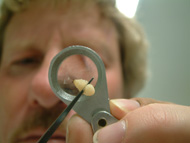Biocontrol to thwart pipe and pasture pest
Note: This content is stored on an archive website and may not be current or accurate. Contact us to clarify.

Irrigated lucerne growers in the Tamworth, Mudgee, Riverina and Hunter regions could soon have a safe biological solution to a major lucerne pest thanks to a NSW Department Primary Industries (DPI) research project.
NSW DPI entomologist, Adrian Nicholas, has already solved an international dilemma when he caught out whitefringed weevil larvae as the culprit responsible for chewing holes in some subsurface drip irrigation pipes.
Now Dr Nicholas is on the trail of a biological control to foil the whitefringed weevil.
"Weevil larvae borrow into the soil where they cause damage to lucerne plants by feeding on their roots," Dr Nicholas said.
"And while they’re down there, they chew through subsurface pipes, making extra holes which reduce the efficiency of irrigation systems and create a costly repair problem for farmers."
An observation chamber is being used in the laboratory to work out why weevil larvae chew plastic pipe.
"They may ‘think’ that it’s a food source, they may be after water in the pipe or maybe they’re attracted to the plastic itself."
Once researchers have that answer the next step is to find a safe biological control which they say will deliver a double whammy by protecting both the pipe and lucerne plant from the pest.
"We should be able to control the whitefringed weevil larvae and that will prevent them from chewing the roots of the lucerne, increase the longevity of the lucerne plants and productivity for growers," he said.
The pipes too will play a part in managing the pest.
On-farm trials are planned to test subsurface drip irrigation as a distribution system for the new biological control.
Lucerne growers can find out more about the whitefringed weevil research project by contacting Dr Adrian Nicholas, ph: (02) 6763 1283, at the Tamworth Agricultural Institute.
Digital photographs available.
Email:

